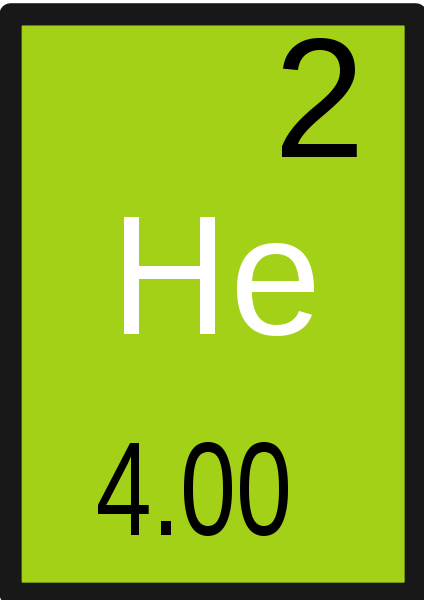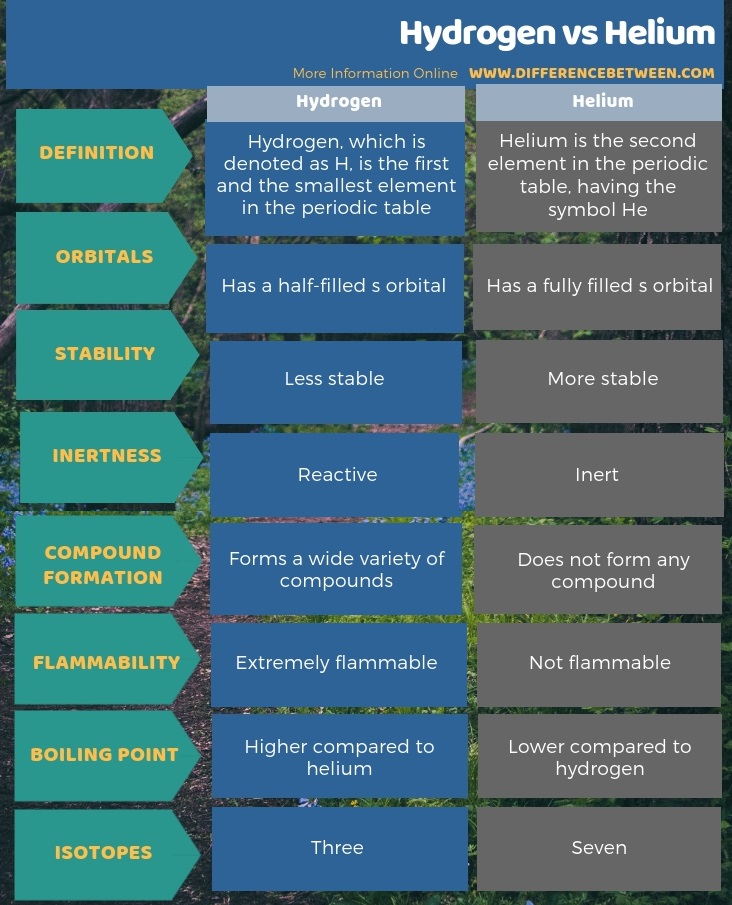The key difference between hydrogen and helium is that hydrogen is a diatomic gas, while helium is a monatomic gas.
Hydrogen and helium are the first two elements in the periodic table. Both are gases and have a high abundance in the universe. They are very simple elements having electrons filled to 1s orbital only. Hydrogen only has one electron, and it can achieve the electron configuration of Helium by obtaining another one.
CONTENTS
1. Overview and Key Difference
2. What is Hydrogen
3. What is Helium
4. Side by Side Comparison – Hydrogen vs Helium in Tabular Form
5. Summary
What is Hydrogen?
Hydrogen is the first and the smallest element in the periodic table, which is denoted as H. It has one electron and one proton. We can categorize it under group 1 and period 1 in the periodic table because of its electron configuration: 1s1. Hydrogen can take up an electron to form a negatively charged ion, or can easily donate an electron to produce a positively charged proton or share an electron to make covalent bonds. Because of this ability, hydrogen is present in a large number of molecules, and it is a highly abundant element in the earth.
Furthermore, hydrogen has three isotopes named as protium-1H (no neutrons), deuterium-2H (one neutron), and tritium– 3H (two neutrons). Protium is the most abundant among three, having about 99% relative abundance.

Hydrogen exists as a diatomic molecule (H2) in the gas phase, and it is a colourless, odourless gas. Furthermore, it is an extremely flammable gas and it burns with a pale blue flame. Under normal room temperature, it is not very reactive. However, in high temperatures, it can react fast. H2 is in the zero oxidation state; therefore, it can act as a reducing agent to reduce metal oxides, or chlorides and release metals. Hydrogen is useful in chemical industries such as ammonia production in the Haber process. Moreover, liquid hydrogen is important as a fuel in rockets and vehicles.
What is Helium?
Helium (He) is the second element in the periodic table, and it is in group 18 (Nobel gas). It has two electrons; therefore, the electron configuration is 1s2. S orbital can only accommodate two electrons, so in helium s orbital is fully filled, making helium an inert gas. The molecular weight of helium is 4 g mol-1.

Helium is a light, colourless, odourless gas like hydrogen. It also has a low boiling point, low density, low solubility and high thermal conductivity. The melting point (0.95 K) and the boiling point (4.22 K) of helium are considered as the lowest values among other elements. Moreover, this gas has seven isotopes, among those only He-3 and He-4 are stable. Helium is lighter than air, so it is used to fill balloons, airships, etc. Furthermore, it is useful for magnetic resonance imaging (MRI), pressurizing liquid fuel rockets, as a cooling medium for nuclear reactors, etc.
What is the Difference Between Hydrogen and Helium?
Hydrogen and helium are the smallest elements and these are the first two elements in the periodic table. The key difference between hydrogen and helium is that hydrogen is a diatomic gas, while helium is a monatomic gas. Helium has a fully filled s orbital (1s2), but in hydrogen, there is only one electron (1s1), so it is unstable. Compared to hydrogen, helium is an inert gas. Moreover, helium is lighter than air, but hydrogen is slightly heavier than air. Moreover, hydrogen is reactive in comparison to helium, so hydrogen forms many chemical compounds, but helium doesn’t.

Summary – Hydrogen vs Helium
Hydrogen and helium are the smallest elements and these are the first two elements in the periodic table. The key difference between hydrogen and helium is that hydrogen is a diatomic gas, while helium is a monatomic gas.
Reference:
1. Khilyuk, Leonid F., et al. “Surface Soil-Gas Surveys.” Gas Migration, 2000, pp. 42–73., doi:10.1016/b978-088415430-3/50004-5.
Image Courtesy:
1. “Hydrogen Deuterium Tritium Nuclei Schmatic-en” By Dirk Hünniger;Derivative work in english – Balajijagadesh – This file was derived from Hydrogen Deuterium Tritium Nuclei Schmatic-de.svg (CC BY-SA 3.0) via Commons Wikimedia
2. “Helium” By me – image:Helium.gif (CC BY-SA 2.5) via Commons Wikimedia
ncG1vNJzZmivp6x7pbXFn5yrnZ6YsqOx07CcnqZemLyue8OinZ%2Bdopq7pLGMm5ytr5Wau2602J2pqJ%2BVo3qiusNmraxlmJq5qsHMaA%3D%3D